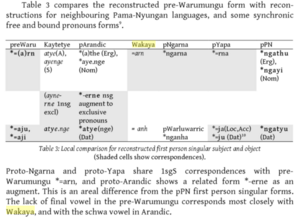Wagaya language facts for kids
Quick facts for kids Wagaya |
|
|---|---|
| Ngarru | |
| Region | Northern Territory |
| Ethnicity | Wagaya, Yindjilandji |
| Extinct | (date missing) |
| Language family |
Pama–Nyungan
|
| Dialects |
Wagaya
Yindjilandji
Bularnu (Dhidhanu, Baringkirri)
|
| AIATSIS | C16 Wakaya, G12.1, G14 |
Wagaya (also called Wakaya) was an extinct Aboriginal language once spoken in Queensland, Australia. Another language, Yindjilandji (Indjilandji), might have been a separate language or a very close relative. A language expert named Gavan Breen studied Wagaya and wrote about its two main forms, or dialects, in 1974.
Contents
What is the Wagaya Language?
Wagaya belongs to a larger group of languages called the Ngarna subgroup. This subgroup is part of the even bigger Pama–Nyungan family of Australian languages. Think of it like a family tree: Pama-Nyungan is the big family, Ngarna is a branch, and Wagaya is a leaf on that branch.
How is Wagaya Related to Other Languages?
Wagaya is most closely related to Yindjilandji, Bularnu, and Warluwarra. Gavan Breen grouped Wagaya and Yindjilandji together into what he called the "Ngarru" group. Bularnu and Warluwarra formed another group called "Thawa." These names came from the word for 'man' or 'Aboriginal person' in those languages. These two groups together make up the southern part of the Ngarna family.
Experts like Catherine Koch and Gavan Breen have studied how these languages are connected. They looked at how the languages might have developed from an older, shared language.
Sounds of the Wagaya Language
Just like English has different sounds for letters, the Wagaya language also had its own set of sounds. These sounds are called consonants and vowels.
Wagaya Consonants
The Wagaya language had many consonant sounds. These included sounds made with the lips (like 'p' and 'm'), sounds made at the back of the mouth (like 'k' and 'ng'), and sounds made with the tongue in different parts of the mouth.
| Lips | Back of Mouth | Front of Gums | Curled Tongue | Teeth | Flat Tongue | |
|---|---|---|---|---|---|---|
| Stop | p | k | t | rt | th | j |
| Nasal | m | ng | n | rn | nh | ny |
| Side of Tongue | l | rl | lh | ly | ||
| Flap | rr | |||||
| Glide | w | r | y |
Wagaya Vowels
Wagaya also had vowel sounds, similar to 'a', 'e', 'i', 'o', 'u' in English. Some vowels could be short or long.
| Front | Center | Back | |
|---|---|---|---|
| High | i, i: | u, u: | |
| Central | e | ||
| Low | a |
Bularnu Consonants
The Bularnu dialect, closely related to Wagaya, had its own set of consonant sounds.
| Lips | Back of Mouth | Between Teeth | Flat Tongue | Tip of Tongue | Curled Tongue | |
|---|---|---|---|---|---|---|
| Voiced Stop | b | g | dh | dy | d | rd |
| Voiceless Stop | p | k | th | ty | t | rt |
| Nasal | m | ng | nh | ny | n | rn |
| Side of Tongue | lh | ly | l | rl | ||
| Tap | rr | |||||
| Glide | w | y | r |
Bularnu Vowels
Bularnu also had vowel sounds, some of which could be long.
| Front | Central | Back | |
|---|---|---|---|
| High | i, i: | u, u: | |
| Low | a, a: |
History and Location
By 1983, there were only about 10 people who could speak Wagaya. Sadly, the language is now considered extinct, meaning there are no native speakers left.
Where Was Wagaya Spoken?
The Wagaya language was traditionally spoken in an area to the northeast and east of a place called Tennant Creek in the Northern Territory of Australia. Other Aboriginal languages were spoken in nearby areas: Alyawarre to the east and southeast, Kaytetye to the south, and Warlpiri to the west.
The approximate center of the Wagaya language area was at these coordinates:
- Latitude: -20.33
- Longitude: 137.62
How Wagaya Grammar Works
Experts have compared the grammar of Wagaya to other Australian languages in the same family. This helps them understand how languages change and develop over time.
For example, the Wambaya language was a neighbor to the Wagaya group. Because of this, there were many similar ways that words and sentences were put together in both languages. A book called A Grammar of Wambaya was written to help younger Wambaya speakers learn their language. This was important because by the late 1990s, only a few people could speak Wambaya fluently.
Many books and articles, like Australian Languages: Classification and the comparative method, talk about Wagaya's unique words and grammar. They show how Wagaya compares to other Australian languages in its family.
An article called “The Ngumpin-YAPA Subgroup” also looks at how languages like Wagaya changed over time. It compares words and spellings, showing how Wagaya shares features with other related language groups.


